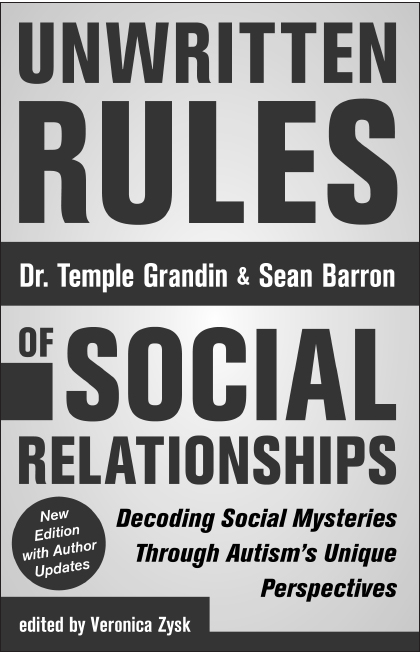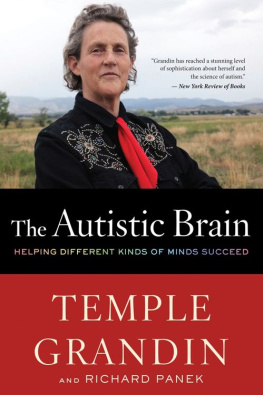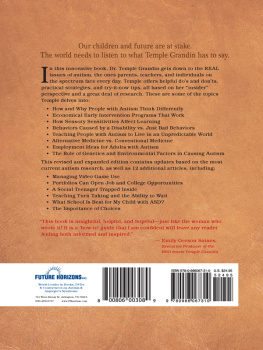

UNWRITTEN RULES OF SOCIAL RELATIONSHIPS
All marketing and publishing rights guaranteed to and reserved by:

721 W. Abram Street
Arlington, TX 76013
(800) 489-0727
(817) 277-0727
(817) 277-2270 (fax)
E-mail:
www.fhautism.com
2016 Dr. Temple Grandin & Sean Barron
Cover & interior design by John Yacio III
All rights reserved.
Printed in the USA.
No part of this product may be reproduced in any manner whatsoever without written permission of Future Horizons, Inc., except in the case of brief quotations embodied in reviews or unless noted within the book.
ISBN: 9781941765388
DEDICATION
This book is dedicated to individuals with autism spectrum
disorders who strive each day to understand themselves
and the world around them, and to the parents, teachers
and providers who help them do so.
Temple Grandin
I would like to dedicate this book to Ron, Judy and Megan
Barron: my wonderful father, mother and sister.
Sean Barron
SOCIAL RULES
Those guidelines, norms, requirements, expectations, customs, and laws,
Written and unwritten, spoken and unspoken,
That reflect a societys attitudes, values, prejudices, and fears,
And determine the roles we play and the actions we take,
As we interact with other people in society as individuals and as groups.
ACKNOWLEDGMENTS TO
FIRST AND SECOND EDITIONS
We wish to thank Veronica Zysk for her valuable guidance and hard work in putting this project together. We also want to thank Wayne Gilpin who, as president of Future Horizons Inc. when the first edition was released, had the original idea for this book. We are grateful for his vision and to be part of the FH family. Though Wayne has now passed on from this life, we work to keep alive his vision of helping people better understand autism and Aspergers syndrome and the challenges and triumphs of those with it. As Wayne was frequently known to say, keep smiling!
A NOTE TO READERS
Three people contributed directly to the final book you are reading. Individual passages written by Temple and Sean are identified with their names throughout the chapters. We owe thanks to our editor, Veronica Zysk, for the rest of the text, which she created on our behalf with our input and direction. It was a true team effort.
We believe in the use of person-first language and have incorporated that styling into the book. However, there are passages where we found it cumbersome or redundant to use person-first language, and the reader will notice the use of the term autistic. We mean no disrespect.
We also chose to globally use the male gender reference, rather than he/she or him/her. The word teacher refers to anyone who works with or has an influence on people with ASD. It is not limited to the formal education system, and professionals and parents alike are all our teachers. Except where noted, the ideas presented in the book apply equally to girls and boys.
Finally, the structure of the book dictated that there be a mixed voice within the chapters. The two opening chapters are written in first-person language, as we each authored our own chapters. The remainder of the book represents a marriage of both our thoughts and ideas; therefore, we chose to refer to ourselves in the third person when necessary.
A FEW NOTES TO READERS ON THE SECOND EDITION
The content and structure of this second edition remain largely the same as the first edition, with two major exceptions:
- Temple and Sean have added content that speaks to some of the social perceptual changes they have experienced over the last 12years, since the first edition released in 2005. The majority of this content can be found in its entirety directly following the first edition content.
- Some readers of the first edition found it challenging to track whether Temple or Sean was speaking in parts of the book. As a result, the reader will now see a vertical ruler running down the outside edge of the page. The ruler to designate Temples content is gray; the ruler to designate Seans content is black. We hope this visual tool makes it easier to appreciate which author is speaking and when.
- Some readers thought our editor should have omitted content across the chapters if it was something we already had said. We didnt want this done for two reasons. First, we never assume people read a book front to back. In fact, many dont. Second, some things bear repeating so people of the spectrum, who process differently, actually hear and understand things that are important to us.
W hen our publisher, Wayne Gilpin, approached us about writing a book together about the unwritten rules of social relationships, we were both, simultaneously, interested and filled with some degree of trepidation. There is value, he asserted, in sharing with the autism community the collective years of wisdom of two successful, socially-adept individuals who struggled with the effects of autism and rose above the challenges of the disorder. You both have insight and experience in the complex arena of social functioning and people want to know how you became the social beings you are.
On a logical, intellectual basis we both could agree with the points Wayne was making. We did recognize the value of broadening the understanding that neurotypical people have of people who are on the autism spectrum, especially in reference to how we think and how that affects our social relationships. We were both able to reflect on the difficult lessons and experiences that contributed to the social understanding we each possess of the world. And, a book like this appealed to us because it is a way of giving back to the world, leaving a legacy of our thoughts on a topic that is ever-present in the minds of parents, teachers, caregivers and people with ASD.
Little did we realize at the time we agreed to write this book what a mirror image of our quest for social understanding it would turn out to be.
While we understood the task at hand, translating ideas into action proved difficult. The farther we journeyed into discussing the content of the book, the more nebulous the theme became. Wed discuss one unwritten rule and a hundred exceptions would instantaneously appear. Anxiety and frustration grew as the project became a giant metaphor for the path our social mastery took as we grew from children to adolescents to the adults we are today. Social rules and exposure to the social world is simple and well-defined at first. As children we are taught Dont talk with your mouth full or Raise your hand in class before speaking. These were concrete rules to follow; they defined what our behavior should be. And it was relatively easy to know when we wereor were notfollowing them. So too was the initial idea for the book: Talk about some of the unwritten social rules you learned along the way. However, the more immersed one becomes in social situations and social understanding, the more intricate and interwoven are those rules, the more nuanced the interpretation of what to do or say, and the less clear-cut these rules become. We descended into that realm of fuzzy boundaries and discovered more exceptions than rules the morewe talked about the book. As we marched forward, the light of understanding and confidence in accomplishing the task before us faded.
Next page
















